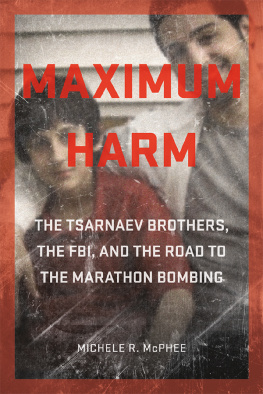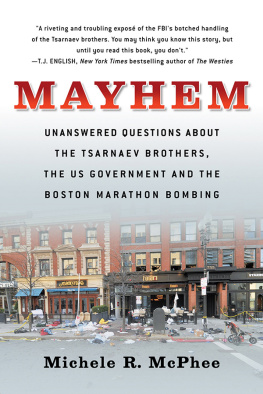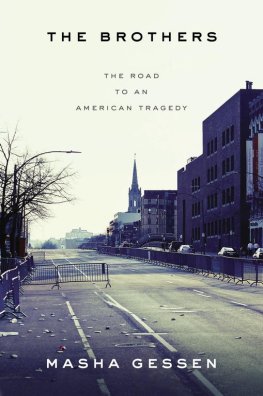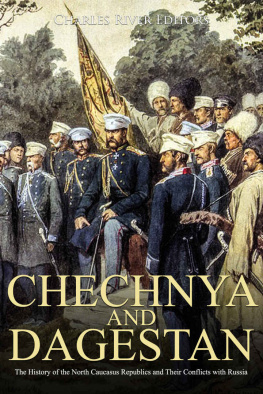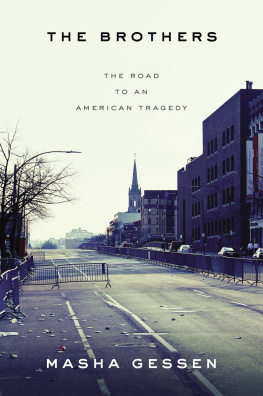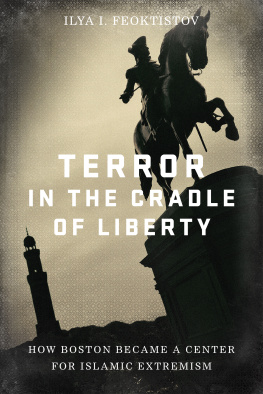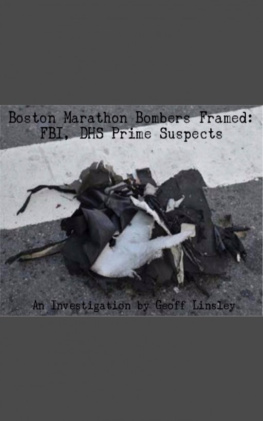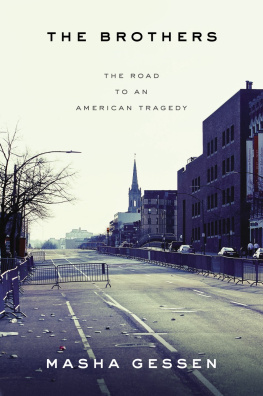
ACKNOWLEDGMENTS
The gathering of evidence is a long, steep road, and some people close to me argued that trying to wangle answers out of members of the federal intelligence community would prove exhausting and thankless. I will admit it was a tremendous undertaking, and I could not have done it without the support of countless law enforcement sources, both on and off the record; court employees (they know who they are); and those who trusted me enough to slip me the sensitive information that helped connect some dots. Most importantly, however, two people believed in this project since the beginning: my doggedly determined literary manager, Sharlene Martin, and my talented and tireless editor, Stephen Hull. I owe them both my utmost gratitude. Amanda Dupuis, the managing editor of University Press of New England, thank you for your help during the editing process.
I am humbled to work alongside the best investigative journalists in the country at the ABC News Brian Ross Investigative Unit. Working with Brian Ross and his vaunted team of investigative journalists has made me a better reporter, and its leaders, Brian Ross and Rhonda Schwartz, have become trusted mentors and friends. There are so many producers, editors, and camera crew colleagues who steered the stellar ABC News coverage of the Tsarnaev trial alongside me at ABC Newsincluding David Reiter, Wendy Fisher, Gregory Croft, and Santina Leuciwho are deserving of mention that I am afraid I could not list them all, but I hope everyone involved knows they have my respect. I do need to give a special thanks to Team Boston: Tom Llamas, Tina Chen, Carlos Boettcher, and the Tom Manning crew. And, of course, there were those who made the long wait for the jury to return the verdict bearable, including Hilary Sargent, then at Boston.com, and Patrick Radden Keefe of the New Yorker, along with WBURs Bruce Gellerman and Emily Rooney, a longtime friend and mentor.
Many of the brave law enforcement officers from every police department in the Commonwealth of Massachusetts, federal prosecutors, defense attorneys, federal agents, and first responders from the Boston Fire Department and EMS who not only saved countless lives that day but also assisted in the reporting, cannot be named. Some can for the guidance they gave me or the Freedom of Information Act requests they answered: BPD spokesman Lieutenant Detective Mike McCarthy and his staff, Massachusetts State Police department spokesman David Procopio, FBI spokesperson Kristen Setera, former Watertown Police Chief Ed Deveau and current Watertown Police Chief Ed Long, Cambridge Police Department spokesman Jeremy Warnick, US Attorneys Office spokeswoman Christina Sterling, US Marshals Service spokesman Kevin Neale, retired Somerville Police Chief Tom Pasquarello, Massport firefighter Michael Ward, and others who I hope know my gratitude, especially the late Mayor of Boston Thomas M. Menino, whom I adored, and his staff, among them Dot Joyce.
Writing any book is a complicated task, and I leaned on a lot of people, most of all my boss; my friend; mo anam cara; the co-owner of the phenomenal radio station 1510 WMEX in Boston, where I have hosted a radio show from 3:00 to 7:00 P.M. since June 2, 2015; and the person who stayed up countless hours editing behind me, as I worked on past the morning side of midnight to meet deadlines. Mary Remmer, I love you. To Marys husband Henry Remmer and the rest of the family at 1510 WMEX, including Bryan Berner, Tom Quinlan, and Ryan Nichols, thanks for putting up with me as I wrote my book and planned my show simultaneously for months. Of course to my girl Diane MacNamara, Di Mac, a special nod.
My family has always pushed me to write, since I was a little girl scribbling notes in my little locked diary. To my sisters Erin Donovan and Shannon Thompson; my godparents, Joan and Dick Dennis; and my father, Bruce, thank you. You all knew that my nosy nature might come in handy one day, especially you Erin. I also want to acknowledge my friends, among them Rob and Raquel, Andrea Ducharme, Noelle Spinosa, Lisa Cappuccio and so many others who patiently listened to my unrelenting theories for three years and pushed me to uncover the truth.
I dedicate this book to the victims: Martin Richard, Krystle Marie Campbell, Lingzi Lu, and Sean Collier, who died at the hands of the Tsarnaev brothers, the seventeen victims whose limbs were torn from their bodies and yet overcame, continuing to inspire all of us to turn tragedy into triumph; and the loved ones whose lives were turned upside-down caring for their critically injured family members. I must also mention the ones who have become honored friends: Rebekah Gregory-Varney, Liz Norden, and Roseann Sdoia.
And, finally, TJF.
AUTHORS NOTE
When two bombs were detonated on Boylston Street, 550 feet away from the finish line of the Boston Marathon on April 15, 2013, a familiar sense of dread came over me. There was no cell phone service. Loved ones were unreachable. At 2:49 P.M., the place just yards from where Id had coffee hours earlier was a war zone. There were body parts, pools of blood, broken glassit was a scene of inexplicable mayhem. Boston was under attack.
That day I began investigating the marathon bombings for ABC News, and I have not stopped since. I was there as crime scene detectives and federal agents collected evidence and when the FBI released photographs of the suspects referred to as Black Hat and White Hat four days after the bombings. Just hours after that release, I raced to Cambridge when those same suspects were believed to have murdered an MIT police officer in cold blood and then carjacked a getaway vehicle. The carjacking victim escaped but left his cell phone behind in his Mercedes SUV. Police used its GPS device to track it to Watertown, my next stop. There, reporters ringed the streets until, in unison, we dove behind cars when we heard bullets being fired and explosives going off during a wild battle between the suspected bombers and the police.
At 1:01 A.M. on April 19, the bullets stopped. More than two hundred spent rounds littered the streets and were recovered from nearby homes. One suspect was dead. The other was on the run. And they had been publicly identified by the FBI as Tamerlan Tsarnaev, twenty-six, and his brother, Dzhokhar, nineteen, two Russian immigrants who had been living in a subsidized apartment in Cambridge. I remained in the paralyzed city of Watertown for the next sixteen hours as SWAT teams searched door to door, telling terrified residents to stay put. Many people were forced to plug bullet holes in their homes. One family had the surreal experience of seeing a round pierce their television set as it was broadcasting news of the insanity going on outside their house. Just after 6:00 P.M., a Watertown man went out for a smoke and found drops of blood that led to his boat, the Slip Away II, dry-docked in his yard. When he pulled back the tarp covering the boat, he saw a bleeding man in the bottom of the boat and scrambled for his phone. Within minutes, cops had ringed the boat, and after one of them seemed to see movement, they fired on it. The first shot was followed by a twelve-second barrage of gun blasts fired by police into the side of the boat accompanied by flash-bang grenades whose hum could be heard blocks away. Then there came the order to cease fire. Dzhokhar Tsarnaev was captured alivejust barely alive. Grateful residents of Watertown lined the streets to cheer the cops as they pulled out of the city later that night. I know a lot of police officers who didnt have to pay for a round of beers that night.
Since then I have attended every arraignment and court appearance of the accused bomber, Dzhokhar Tsarnaev, and four other men charged in the attacks, his college friends who were imprisoned for lying to investigators in a terrorism case.
Next page
